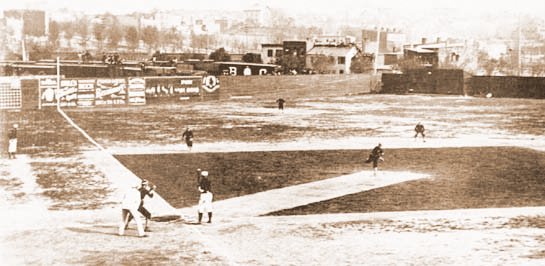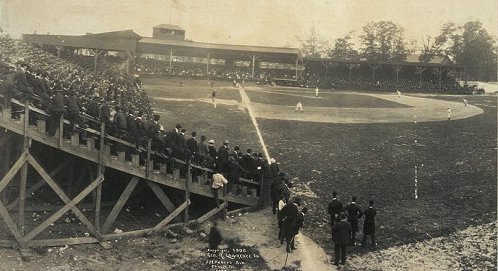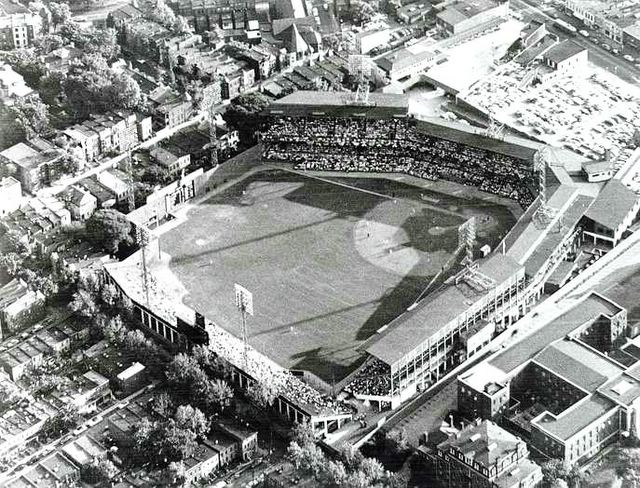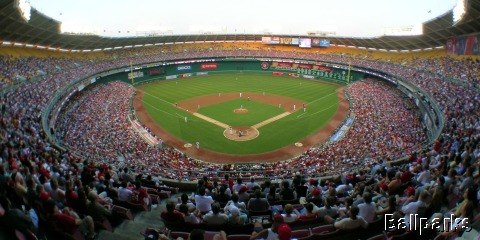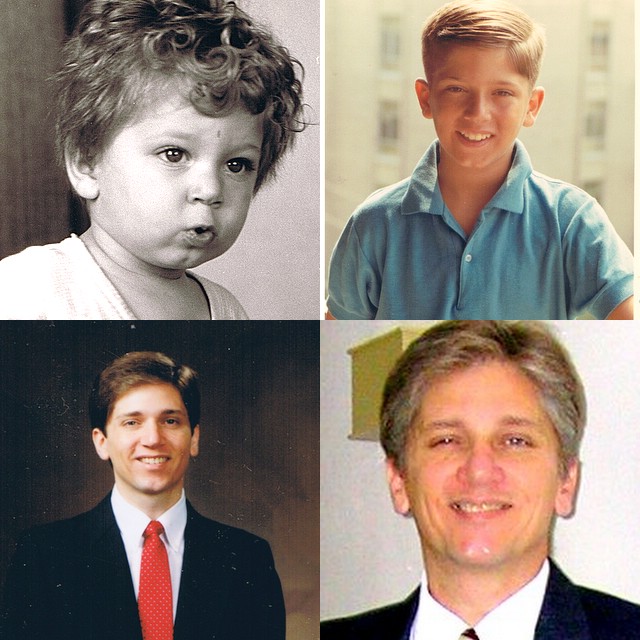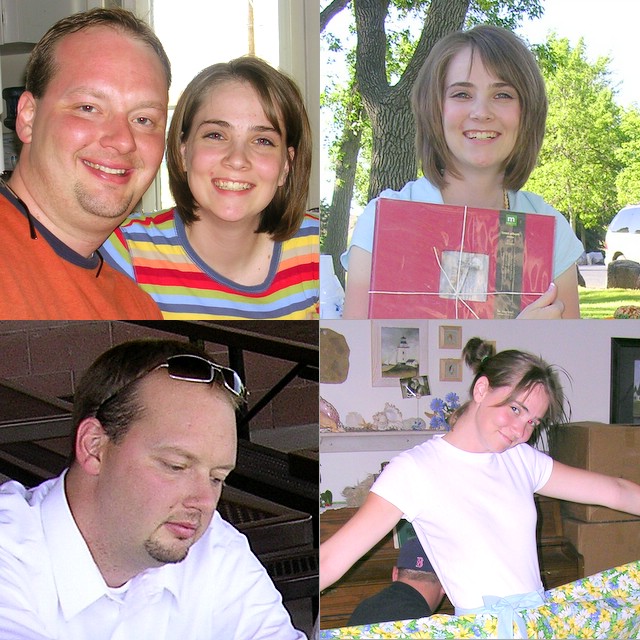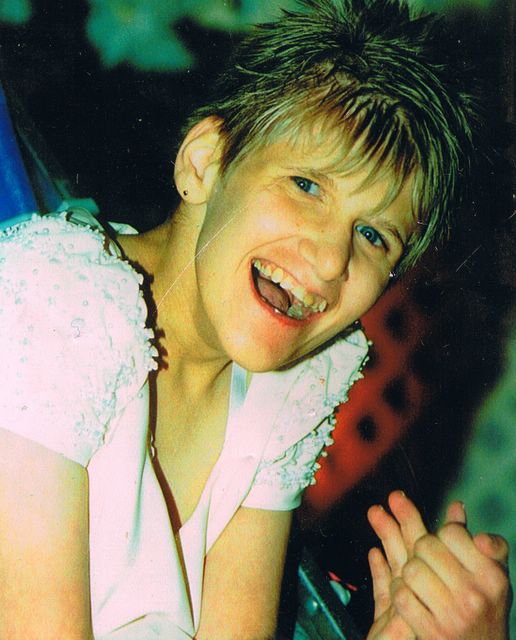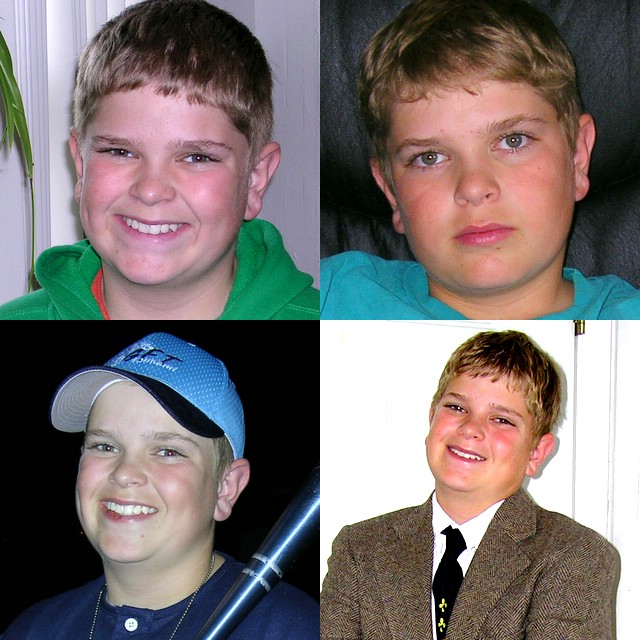Game 1: The Kia Tigers
 [February 28th] -- Usually, the first game of spring training is against a patsy; a college team or a rag-tag all star team from Dubai. The Nationals chose to play the Kia Tigers, baseball's version of the old "Washington Generals" that played foil to the Harlem Globetrotters for years. You know, fill out the uniforms and don't hurt anyone. And get clobbered.
[February 28th] -- Usually, the first game of spring training is against a patsy; a college team or a rag-tag all star team from Dubai. The Nationals chose to play the Kia Tigers, baseball's version of the old "Washington Generals" that played foil to the Harlem Globetrotters for years. You know, fill out the uniforms and don't hurt anyone. And get clobbered.
Memo to Nationals: don't phone it in on Wednesday.
In the first game of spring, The Kia Tigers mauled the Cincinnati Reds 12-4.
Dave Williams, obtained over the winter from the Pirates for Sean Casey, gave up five runs on 35 pitches in the first inning, including a long home run by Lim Sung-min.
The Nationals lineup will be full of rookies and second year players, so the outcome of the game doesn't mean much. What makes this story so interesting is how far baseball in the Pacific Rim has come. ABC's Wide World of Sports first broadcast an American-Japanese all star game [that I remember] following the 1968 season. The Americans pummeled the Japanese game after game after game. As I remember, the Americans won 12 of 13 games in the series. The Japanese players looked like children awed in the presence of their heroes.
star game [that I remember] following the 1968 season. The Americans pummeled the Japanese game after game after game. As I remember, the Americans won 12 of 13 games in the series. The Japanese players looked like children awed in the presence of their heroes.
I got to see many when I lived in Japan in the late 1970's. I felt at that time that their defense was every bit as good as ours, and the pitching was very good as well. However, Japanese pitchers were all about movement and nibbling on the corners. I don't remember any dominant fast-ball pitchers in the league. The good hitters were in the mold of Ichiro, quick and disciplined. The home runs were fewer even though the fences were on average 20-30 feet closer in than the American ballparks. I had an opportunity to go TDY to Korea [former military personnel knows what that means :)] and saw a professional game during my stay. The stadium wasn't much more than what the Potomac Nationals play in today. Today, the teams play in 35,000 seat concrete facilities that are filled nightly.
Today, there isn't much difference in the quality of the top players in both regions, although we have many more top players than you'll find in Japan or Korea. I will say that fans in Japan are far more rapid then here in the States.
than you'll find in Japan or Korea. I will say that fans in Japan are far more rapid then here in the States.
All around the stadiums in Japan are "boosters" who act like cheerleaders. They are each responsible for a section, and they make sure their fans scream and shout the loudest. Most fans bring noisemakers into the stadium, giving the game more of a feel of a college football game.
I'm not sure who I'm going to root for. While I love the Nationals, I did buy two Kia's a couple of months ago. Maybe my purchase bought a few jerseys for the team.
Nah. Go Nats!
DRESE QUESTIONABLE FOR OPENING DAY -- IS THAT A GOOD THING OR A BAD THING?
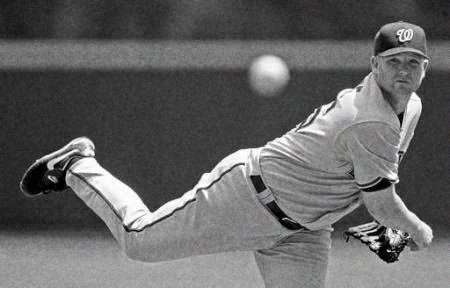 [February 28th] -- Livan Hernandez's knee is "fine" but the Nationals are going to take it slow with their big right-hander. Luis Ayala's elbow is "tender" but team official's think he'll be okay "soon." Robert Fick has "floaties" in his right elbow but he's going to "gut it out" this year before having surgery. Brian Lawrence is likely done for the year. And Ryan Drese? Well, that depends on who you ask.
[February 28th] -- Livan Hernandez's knee is "fine" but the Nationals are going to take it slow with their big right-hander. Luis Ayala's elbow is "tender" but team official's think he'll be okay "soon." Robert Fick has "floaties" in his right elbow but he's going to "gut it out" this year before having surgery. Brian Lawrence is likely done for the year. And Ryan Drese? Well, that depends on who you ask.
The team is saying that he is throwing pain free, but they want Drese to take it slowly. Hmmm. Sound familiar? After a winter of reports that Drese would be "good to go" by spring, the Washington Post is reporting that team officials still think there is a "chance" that Drese will be available on opening day. A chance? The Nationals need more than a "chance." Livan Hernandez is coming off of an injury. Tony Armas Jr. is coming off an injury. Newly signed Pedro Astacio has had is innings cut short the past three seasons because of injury. Ramon Ortiz is healthy, but he hasn't had a solid season in four years. John Patterson is in good shape, but he tired late last year due to the number of innings he pitched.
There are more questions in the rotations then answers. And that's scary. What does it say about a team's chances when they are counting on Ryan Drese to remain healthy? Livan should do well, and Patterson ought to continue to improve. But the Nationals have to hope that the rest of the rag-tag back of the rotation group stays healthy AND has career years. If both happens, the Nationals will be just fine. But if the planets don't align just right, well, I just don't want to think about it.......
Welcome Aboard, Pedro Astacio
 [February 27th] -- Wasn't it just yesterday that Nationals' general manager Jim Bowden said that the team was no longer talking to Pedro Astacio, that he was asking too much money, that he didn't want to be pay a "premium" just because Brian Lawrence got hurt?
[February 27th] -- Wasn't it just yesterday that Nationals' general manager Jim Bowden said that the team was no longer talking to Pedro Astacio, that he was asking too much money, that he didn't want to be pay a "premium" just because Brian Lawrence got hurt?
Why yes, I think it was just yesterday.
Nonetheless, The Nationals have signed Pedro Astacio to a one year, $700,000 contract that kicks in an additional $500,000 if he goes north with the team. If he's a good boy and puts up some Lawrence-like numbers, he could make as much as $2 million. The Nats beat out both the Rockies and the Reds, as well as the Padres, who offered him a major-league contract that would have begun on May 1st, the first day his old team could sign him.
Astacio's best season came in 1993, when he went 14-9, 3.57 with the Los Angeles Dodgers. He won 17 games with the Rockies in 1999m although his ERA took a beating at Coors Field. The rest of his career has been up-and-down, with no more so than in 2005. He went 2-8, 6.04 with the Rangers before being released. With the Padres, he was a stud, going 4-2, 3.17.
Astacio is an innings-eater who has a moving fastball that tops out in the low 90's. He has a good change-up, a big curve and a hard slider. He gets rid of the ball quickly, which keeps base runners close; his stolen bases-against numbers are very good. On the bad side, he starts out vey slow, typically having an ERA much higher in the first half of the year. He's not a bad defender; he just gets so caught up with the batter that he kind of forgets where he is. And he's 36.
That said, the guy has a career major league record of 124-119. His strikeout to walk ratio is well above 2:1. He's averaged 204 innings per season over his career. He is what he is; a bottom-of-the-rotation guy who'll likely end up with about 10 wins and an ERA in the 4.15 range. This is a good signing. It replaces a 200+ inning pitcher with another 200+ inning pitcher without having to give up Ryan Church, Nick Johnson, and yes, even Alfonso Soriano. Brian Lawrence's track record indicated he would have, should have, won 10-12 games this season. With Astacio in place, the team shouldn't miss a beat.
Hopefully, he'll pick up where he left off last season. Hopefully, he'll earn the entire $2 million. That would be a win-win for everybody.
BRIAN LAWRENCE DONE FOR YEAR, PROBABLY ENDS CAREER IN D.C. BEFORE IT STARTS
 [February 26th] - It went from bad to worse.
[February 26th] - It went from bad to worse.
It looks like the Nationals got rid of Vinny Castilla for nothing after all.
The doctors who operated on Brian Lawrence's shoulder Sunday morning at D.C.'s Washington Center Hospital said that the damage to his labrum was "extensive." In addition, there is a great deal of damage to his rotator cuff as well, making it highly unlikely that Lawrence will be able to return to the Nationals before spring training of next year.
Lawrence's 2006 contract calls for a very servicable $3.7 million dollar salary. However, the club has a team option to resign the former Padre at $5.7 million in 2007 or buy him out for $550,000. Even if [and this may be a big if] the new owner is in place and can afford to keep him, do they want to? $5.7 million is a lot of money to pa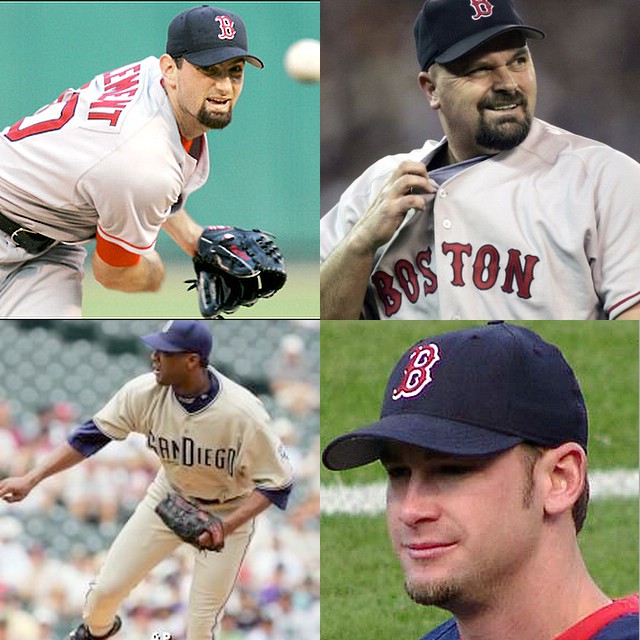 y a pitcher who will have at best pitched a token number of innings in rehab before the team must make a decision. Lawrence may join Alfonso Soriano as two players who will never play a regular season game with the Nationals.
y a pitcher who will have at best pitched a token number of innings in rehab before the team must make a decision. Lawrence may join Alfonso Soriano as two players who will never play a regular season game with the Nationals.
Nationals GM Jim Bowden is probably in "panic mode" tonight as he tries to find a suitable replacement for Lawrence. Pedro Astacio is being courted by the Reds and Rockies, and the Padres have a standing major league offer that would begin on May 1st, making it less likely that he'll sign with Washington. Bowden talked to the Red Sox today about David Wells, but his salary (up to $9 million) and his desire to go home to San Diego might make this a difficult deal to complete. The Boston Herald is reporting that Jim Bowden is also looking at Matt Clement or Bronson Arroyo, though Clement's salary may be a little high for the Nationals. The Red Sox seem interested in a package that would need to include Ryan Church or Nick Johnson. I'd rather see Alfonso Soriano included in any deal with Boston. I still think that Ryan Church will become a special player in this league.
It's bad news, but at least the team now knows what they are up against as they plan for the 2006 season. Let's hope Bowden remains sane over the next week or two and doesn't do anything stupid.
Again.
What Did He Know, And When Did He Know It?
 [February 26th] -- Not since the days of Watergate has Washington been awash in conspiracy theories of this magnitude. Although Howard Baker isn't saying it, the blog-o-sphere is: "What did Kevin Towers know, and when did he know it?"
[February 26th] -- Not since the days of Watergate has Washington been awash in conspiracy theories of this magnitude. Although Howard Baker isn't saying it, the blog-o-sphere is: "What did Kevin Towers know, and when did he know it?"
Now, I have no clue as to whether the Padres' general manager knew that Brian Lawrence was damaged goods. My guess is that he did not. That doesn't mean, however, that he was blind to the fact that there was something "different" with his former opening day starter.
In four major league seasons, Brian Lawrence was remarkably consistent. He averaged 10 wins and 206 innings per year. His ERA during 2002-04 was 3.69, 4.19 & 4.12 respectively. Halfway through last season, Lawrence's ERA was 4.14 and he seemed on the way to yet another cookie-cutter, just-above-average year. Then, something happened. He struggled in the second half of 2005, posting a 5.86 ERA in his last 19 starts. Shortly thereafter, he was traded to the Nationals.
I don't believe that Towers had any tangible proof that his pitcher was ailing, but he wouldn't be a very good general manager if he didn't realize that something was wrong. His velocity was typically 83-84 mph, down from the high 80's in 2002.
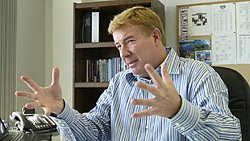 Lawrence never missed a start, never experienced any pain, and believed he was healthy. Towers, however, has supervised hundreds of pitchers over his career, and likely picked up on the signals that Lawrence's stats were telling. He did the right thing by moving Lawrence.
Lawrence never missed a start, never experienced any pain, and believed he was healthy. Towers, however, has supervised hundreds of pitchers over his career, and likely picked up on the signals that Lawrence's stats were telling. He did the right thing by moving Lawrence.
That brings us to Jim Bowden. The Nationals general manager told reporters that the team scouted all of Lawrence's starts the last month of the season. He saw him pitch a three-hit shutout personally. He was healthy, or so he thought. But if Towers could read his tea leaves properly and make the move at just the right time, then why couldn't Jim Bowden see the same thing with the same tea leaves? Was Bowden duped or is he simply a dupe?
I don't know, and probably, we'll never know. That said, consider this: Last October, the Nationals could have released Vinny Castilla and no one would have really cared. We were stunned that "Trader Jim" could have gotten so much in return for a washed-up third baseman.
"How did he do it?" we all asked.
We know now, don't we?
Brian Lawrence Injured, Out Until All-Star Break
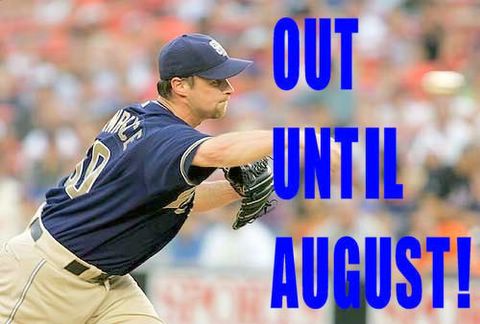 [February 25th] -- The Nationals Farm Authority website, who has a man in Viera, reported Saturday that the Nationals have announced that Brian Lawrence is injured and is not expected to return until August.
[February 25th] -- The Nationals Farm Authority website, who has a man in Viera, reported Saturday that the Nationals have announced that Brian Lawrence is injured and is not expected to return until August.
Lawrence, obtained in a trade last fall for Vinny Castilla, began feeling pain in his shoulder shortly after reporting to spring training. Initial reports indicated that he would have surgery to repair the tear, but team officials indicated later that he would rehab the shoulder instead. However, the team announced late Saturday that he would have the surgery in Washington on Sunday.
My first reaction is to wonder how this will effect the Nationals chances in the NL East this season. The answer is that it won't. The only obtainable goal is to finish out of last place in 2006. Considering that the Florida Marlins imploded over the winter, the Nats would have to lose much more than Brian Lawrence to risk finishing in the basement for the second year in a row.
There is an upside to this. Going in to camp, the Nationals had seven pitchers, Livan Hernandez, John Patterson, Ryan Drese, Tony Armas Jr., Ramon Ortiz, Jon Rauch and Lawrence battling for five positions.
Another possibility would be to sign a free-agent to replace him. Just yesterday, Bowden indicated that signing Pedro Astacio would be a long-shot as the sides were just too far apart on the dollars. That may have now changed. There isn't any other pitchers of consequence remaining in the market, other than Kevin Brown.
The more likely possibility, however, is that Lawrence's torn labrum might spell the end of Alfonso Soriano's career in D.C. even before it started. There are many quality starting pitchers on the market, and Bowden, should he choose to, could easily package Soriano and a prospect for a number-two reliever.
 With Lawrence out of the picture for several months, someone will be given the opportunity to "step up" and earn their place in the rotation. Right now, only Livan and Patterson are locks. Ramon Ortiz and Tony Armas Jr. are likely "near-locks." That leaves Rauch and Drese to battle for the final spot. If the team is looking to the future, they should give Rauch every chance to succeed. If, however, Bowden wants the team to do just "well enough" to allow him to keep his job, Drese might be the guy.
With Lawrence out of the picture for several months, someone will be given the opportunity to "step up" and earn their place in the rotation. Right now, only Livan and Patterson are locks. Ramon Ortiz and Tony Armas Jr. are likely "near-locks." That leaves Rauch and Drese to battle for the final spot. If the team is looking to the future, they should give Rauch every chance to succeed. If, however, Bowden wants the team to do just "well enough" to allow him to keep his job, Drese might be the guy.
The loss of Brian Lawrence isn't catastrophic. It is, however, proof that just because the team suffered through an inordinate amount of injuries last year that we won't be spared in 2006. Rather than trade Soriano for pitching, I'd prefer to let Rauch get his chance and package Soriano away for a hitter.
The more things change, the more they stay the same. At least when the Nationals are involved, that is.
Primary Colors
 [February 25th] - There are a lot of "heavy" stories to consider this Saturday morning. Will Alfonso Soriano play in the outfield? Will he stay with the Nationals? Is Jose Vidro's knee healthy [finally]? Will Ryan Zimmerman be able to start this season the way he left off in 2005? These are all very important.
[February 25th] - There are a lot of "heavy" stories to consider this Saturday morning. Will Alfonso Soriano play in the outfield? Will he stay with the Nationals? Is Jose Vidro's knee healthy [finally]? Will Ryan Zimmerman be able to start this season the way he left off in 2005? These are all very important.
Forget all that. Let's talk about something fun.
Overall, I was very happy with the Nationals' uniforms last year. They kept the "curly W" as a tip-of-the-cap to the city's baseball fans from a generation ago [that's me, and I do appreciate it]. The overall cut and color of the game day uniforms, both home and away were very sharp. I've never liked the way the "WASHINGTON" and "NATIONALS" lettering on the jerseys starts off large, becomes smaller and then gets big again. Perhaps the designer did that to better fit the large number of letters onto that small space [By the way, did you know that an employee of Major League Baseball designed the team's new uniforms while sitting in a motel room in Boston watching the 2004 World Series? Graphics were his hobby, and Bud Selig, afraid the league was running out of time, told his employee to "get it done" that night]. But other than that, I've been very happy with the way the looks on the f ield.
ield.
The red batting practice jersey was also a stunner. I loved the way the interlocking "DC" stood out on the bright red background. The gold piping was very obvious, even from a distance. However, those have been replaced by the new, all blue "bp" jersey. It's just, well, too "blah." The first images out of Viera indicate that the jersey doesn't photograph well.
[Ed. note: After 30 years as a professional photographer, I know all too well that dark material absorbs light and can screw up a camera's light meter, making photos of the Nats' new jersey looks muddy and without texture] The gold in the 'DC' logo is barely noticeable.
I don't like it.
I guess the good news is that, once spring training is over, we'll hardly ever see it. Unlike last season, when the team wore the batting practice jersey in a game, the Nationals now have an "alternate" team jersey which is, thankfully, red and very similar to last year's "bp" jersey.
Ok. I'm done. Thanks for listening to my rant.
The 800 Pound Guerilla Arrives In Camp
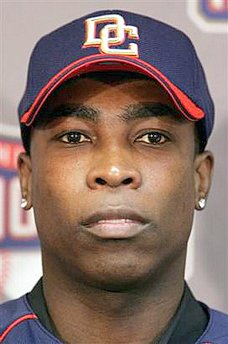 [February 24th] -- We hoped, we prayed, that this would have taken care of itself before the start of spring training. Let me first say that I don't blame Alfonso Soriano one bit. He has once before told a new employer that he didn't want to play in the outfield. Jim Bowden traded for Soriano with the express purpose of moving him to the outfield. But he didn't ask Soriano if he was willing. Oh sure, I understand the system wouldn't allow Bowden to contact the Rangers second baseman before the trade to ask him; it would be tampering. But if you asked me the day before the trade if there was one second baseman that I knew wouldn't switch to the outfield, it would have been Soriano. It was a no-brainer.
[February 24th] -- We hoped, we prayed, that this would have taken care of itself before the start of spring training. Let me first say that I don't blame Alfonso Soriano one bit. He has once before told a new employer that he didn't want to play in the outfield. Jim Bowden traded for Soriano with the express purpose of moving him to the outfield. But he didn't ask Soriano if he was willing. Oh sure, I understand the system wouldn't allow Bowden to contact the Rangers second baseman before the trade to ask him; it would be tampering. But if you asked me the day before the trade if there was one second baseman that I knew wouldn't switch to the outfield, it would have been Soriano. It was a no-brainer.
He reported today, and was all smiles. He listened for two hours as Frank Robinson and Jim Bowden extolled him with the virtues of changing positions. Pete Rose did it. Rod Carew did it. Carl Yaztremski did it. Soriano said he was impressed. He also said it didn't matter; he wasn't changing positions. He's practicing at second base until he leaves for the WBC [the position he'll play there]. That the trade was a stupid move on Bowden's part is moot at this point. The focus needs to be not on the past but on today. The Nationals have about a month to figure all of this out.
Second base belongs to Jose Vidro. He is a former all-star who has come to spring training healthy for the first time since 2003. He has dropped weight and spent the off-season working out with a personal trainer. When the Nationals could no longer keep him out of the WBC, Vidro himself withdrew so that he could commit to the Nationals as he prepared for opening day. Vidro is a team leader and when healthy [which he seems to be], is one of the finest second baseman in the league.
There is no way the Nationals are going to trade him with a multi-year contract binding him to the club for a few more years in favor of one of the worst fielding second baseman in the "bigs" who will be "outa here" come October 1st.
 Soriano has two options: move to the outfield or be moved to another club before the beginning of the regular season.
Soriano has two options: move to the outfield or be moved to another club before the beginning of the regular season.
Soriano is one good season away from [at a minimum] a four year, $52 million dollar contract. If Johnny Damon is worth that kind of money, then Soriano is certainly worth as much, maybe more. By refusing to make the move, [when combined with some of the things he said the past few months], other teams might consider him a "troublemaker" and either reduce their offer or go in a different direction entirely. He's going to ultimately have to make the move or risk ending up in the same category with Gary Sheffield and Barry Bonds.
And the sad part is, he's a really nice guy. Nick Johnson, a former teammate in New York, said he was funny and kept the clubhouse loose. This blog, and many others, have eviscerated him for his "attitude." But really, what attitude? Say you agreed to work for Boeing as an engineer designing landing gear. You love tires and you enjoy your job. Then Boeing gets bought out by Airbus and they transfer you to London to work on radar systems. You hate radar. You tell them you don't want to move to London, and you don't want to work on radar.
What do you do?
If you continue to complain, you'll be branded a "troublemaker," but none of this was your doing. You were working on a hydraulic fitting one day and your world suddenly turned upside down. Soriano is facing the same situation. He was doing his job with the Rangers the best he could, and suddenly his world was turned upside down. It's one thing to be traded without your permission; it's something else altogether to be traded and then forced to switch positions.
I want him to play the outfield, but I guess I understand if he won't make the move. But in the end. I just want it all to go away.
Gone For A Day, But For A Good Cause
 [February 22nd] -- I'll be off the bloggers highway until sometime Thursday evening. My wife and I have a young foster son who has recently gone through four very painful surgeries to repair his cleft palette. We'll be in Salt Lake City having him checked by his surgeon. They tell me that by the time he has his last surgery, all that will be left of that gaping hole will be a small "s" shaped scar just below his nose that will be hardly noticeable by the time he's a teenager.
[February 22nd] -- I'll be off the bloggers highway until sometime Thursday evening. My wife and I have a young foster son who has recently gone through four very painful surgeries to repair his cleft palette. We'll be in Salt Lake City having him checked by his surgeon. They tell me that by the time he has his last surgery, all that will be left of that gaping hole will be a small "s" shaped scar just below his nose that will be hardly noticeable by the time he's a teenager.
Since I was a kid, I've always had an infinity for the "imperfect" of the world. Two of my children, Kendi, who died two years ago at the age of 20, and Katie, now 16, were born with severe physical and mental deficiencies. It's a great responsibility to try to help those who can't tell you their needs, but it's a blessing at the same time. Had I not raised two handicapped children, I probably would to this day be "afraid" of those with special needs. These days, in my family at least, they are the normal ones.
My, how times have changed. J.E.B. Stuart High School [this was in the early 1970's] had a room where "they" went to class. They never came out; they never interacted with the traditional school population. As a result, we had to "fill in the blanks" about them. And, as most kids are want to do, the blanks were filled in in a very unflattering way. Today, ten to fifteen of the "regular kids" volunteer part of their day in the resource room at my daughter's high school. They interact with my daughter and her classmates. The student's learn that there is nothing to be afraid of, that but for the grace of God go they. Many times, I have walked down a hallway only to find a student "racing" with my daughter in her wheelchair. Both were giggling uncontrollably, and my baby always was allowed to win. My daughter doesn't even realize that she's different, thanks to those peer tutors who care.
I'll post again Thursday afternoon. Best wishes to all of you.
Reclaiming The Past II: Ramon Ortiz
 [February 22nd] -- A pitcher who has been successful through most of his career has a terrible year. Nobody wants him. He waits and waits for a phone call that never comes. Then, as spring training uniforms are being boxed at Mizuno's Osaka plant and readied for shipment to Viera, a contract is offered and quickly accepted. The pitcher understands the seriousness of the situation. A second bad year in a row and he might not be offered another contract. Anywhere.
[February 22nd] -- A pitcher who has been successful through most of his career has a terrible year. Nobody wants him. He waits and waits for a phone call that never comes. Then, as spring training uniforms are being boxed at Mizuno's Osaka plant and readied for shipment to Viera, a contract is offered and quickly accepted. The pitcher understands the seriousness of the situation. A second bad year in a row and he might not be offered another contract. Anywhere.
His name was Esteban Loiaza.
This spring, Ramon Ortiz fills the role of the pitcher using his last chance. Like, Loiaza, the fall was fast and stunning. His first two years in the major leagues was typical, full of both promise and problems. He went 10-9 with a 5.32 ERA. He showed a high velocity fastball but because of his diminutive stature, his release point made his heater very fast but very straight. Batters were either striking out or hitting long, long home runs. By 2001, however, he was becoming an effective pitcher. He went 13-11 in 2001 with a 4.36 ERA. He won 15 games in 2002, winning two games in the World Series. Ortiz won 16 games in 2003, but saw his ERA rise to 5.20, the victim of a high fastballs and towering home runs. He was relegated to the bullpen for much of 2004, going 5-7, but he brought his ERA down a full run per game.
It wasn't enough. The Angels had seen enough, and didn't believe that Ortiz would again regain his form. He was traded to the Reds in the off season for minor league prospect Dustin Mosely. The fresh start didn't help. In 30 starts, Ortiz went 9-11 with a 5.36 ERA. He gave up 34 home runs. No one else wanted him. Only the Nationals.
Ortiz's fastball is consistently clocked in the 93-94 mph range, and can occasionally hit 96 when he needs to get a batter out. He's a bulldog on the mound, willing to throw any pitch at any count in any situation. He dares the batter to hit the ball. The problem is, they usually do. Ortiz gets rocked by left handers, and has given up as many as 40 home runs in a season. He throws too many pitches per inning, and usually gets beat by grooving a fastball on a 3-2 count with runners on base.
Hopefully, 2005 was an aberration. He gave up 206 hits in 171 innings. His strikeout totals continued to decline. Some of those numbers could be blamed on the small Cincinnati ballpark, but certainly not all of them.
Maybe Ramon Ortiz is the next Esteban Loiaza. Maybe he'll win 14 games and he'll get a multi-year deal somewhere else just like Loiaza did. But, maybe not. Probably not. Ortiz' internal numbers are far more scary than Loiaza's were heading into 2005. For Ortiz to return to the world of the "living," he's going to have to keep the ball down, allow his defense to do their job, and get outs using fewer pitches.
And pray. He's got to get help from a higher authority, and I'm not talking about Randy St. Claire.
Bowden [Finally] Planning For Nationals' Future
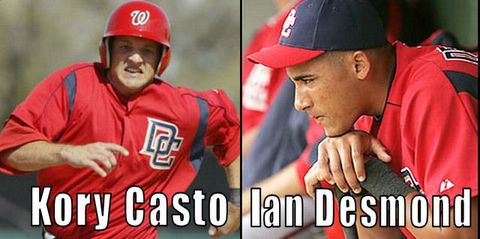 [February 21st]-- Buried deep within one of the many "catch-all" stories coming out of Viera Florida this week was this tidbit: "Jim Bowden said top shortstop prospect Ian Desmond is slated to begin this season at Class AA Harrisburg, and his double-play partner is expected to be Kory Casto, whom the Nationals will move from third base to second base because the presence of 21-year-old third baseman Ryan Zimmerman blocks his path to the majors. Desmond, 20, is ranked fourth on Baseball America's list of the top 10 prospects in the Nationals organization, while Casto, 24, is ranked sixth. They spent last season in Class A.
[February 21st]-- Buried deep within one of the many "catch-all" stories coming out of Viera Florida this week was this tidbit: "Jim Bowden said top shortstop prospect Ian Desmond is slated to begin this season at Class AA Harrisburg, and his double-play partner is expected to be Kory Casto, whom the Nationals will move from third base to second base because the presence of 21-year-old third baseman Ryan Zimmerman blocks his path to the majors. Desmond, 20, is ranked fourth on Baseball America's list of the top 10 prospects in the Nationals organization, while Casto, 24, is ranked sixth. They spent last season in Class A.
"We'll have them play together, so they can come up together" through the farm system, Bowden said."
Although both shortstop Cristian Guzman and second baseman Jose Vidro have years left on multi-year contracts, neither are likely to fulfill those agreements in a Washington uniform. Guzman had a terrible season in 2005, and the only thing that kept him in the lineup was the unwillingness of the Nationals to eat the remaining three years of his contract. Guzman will be easier to move after this season when only two years remain on his deal. Jose Vidro has become fragile and missed significant time the past three seasons. Another long span on the disabled list will likely force the Nationals to consider other options at second.
Ian Desmond's future looks bright, but his flashes of brilliance have been just that; flashes. In 700 plus at-bats in the minors, he has a career .244 batting average with a .296 on-base percentage. He made a combined 39 errors playing for Savannah and Potomac, both class 'A' leagues, last year. Bowden, however, isn't concerned. "Ian Desmond has played at levels in the minors commensurate with what he will do, not what he has done so far. Every time he begins to improve at a particular level, we've promoted him. Certainly, his numbers at Savannah didn't warrant a ticket to Potomac, but we felt that once he wasn't over-powered by the pitching, it was time to move on." The errors don't bother him either. "They're mechanical, kid mistakes. Remember, he's only 20."
Some say he has Derek Jeter talent. Other's have compared his major league career upside to that of current National Royce Clayton. We'll just have to see.
Kory Casto is a different story. At 24, he has the experience and the maturity to play at a higher level. Last season, Casto batted .290-22-90 with a .394 OBP for the P-Nats. However, Casto's ascent through the team's farm system has been as slow as Desmond's has been fast. Coming out of the University of Portland, Casto has spent full-seasons with Vermont, Savannah and Potomac last year. If he spends 2006 at Harrisburg and '07 in New Orleans, he'll be a 26 year old rookie when he makes it to the Nationals. It'll help Casto greatly if he could end 2006 in New Orleans.
There is no question that Ian Desmond and Kory Casto are the team's middle-infield of the future. There isn't anyone else in the system, and short of bringing in a free agent, they, along with Larry Broadway and Ryan Zimmerman, could be part of an infield that stays together for years.
That said, what's the chance of four prospects all making good in the major leagues? It just doesn't happen often.
Nationals Sign Kevin Gryboski
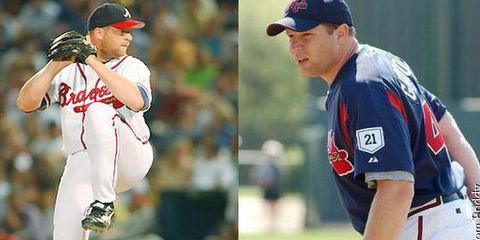 [February 20th] - There are signings, and then there are "signings."
[February 20th] - There are signings, and then there are "signings."
This one is definitely a "signing."
The Nationals signed former Braves' reliever Kevin Gryboski to a minor league contract with a invitation to the team's major league camp.
From 2002-2004, the 32 year old right-hander averaged 50 innings and 61 games per year with a solid 3.39 ERA for the Braves. Last season, the pitched 21 innings with Atlanta with a 2.95 ERA before being traded to the Rangers for Matt Larenzo, where he amassed an ERA above 11.00 in 10 innings. He was released at the end of the season.
I don't get it. For all but ten innings in a four year career, Gryboski was a rock in the Braves' bullpen, pitching 60 innings per year and keeping things safe for Atlanta after their starter's tired and before John Smoltz entered the 9th inning. Then, after a couple of bad outings with Texas, he's released and goes unsigned during the off season, finally signing with a team whose only real strength is it's bullpen.
If he's truly "done," then why sign him? And if he isn't, why did he sign with Washington? Gryboski is a ground-ball pitcher, making him ideal for small parks where balls tend to fly out easily and often. Yet, not one of those teams playing in band-boxes was willing to sign him to a minor league contract, and is forced to sign with Washington, whose need for a ground-ball pitcher is diminished by the expansive outfield at RFK.
These, and other important questions will be answered in Vierra this spring. For now, though, I haven't a clue as to what Jim Bowden is up to.
Reading Between The Lines
 [February 19th] -- I love talking politics with my friends and neighbors here in Idaho. I was sitting in church last week when a good friend sat down next to me. "Can you believe what the governor said last week?" he asked me as the music began to lower and our clergyman began to speak. "How could he think such a thing!."
[February 19th] -- I love talking politics with my friends and neighbors here in Idaho. I was sitting in church last week when a good friend sat down next to me. "Can you believe what the governor said last week?" he asked me as the music began to lower and our clergyman began to speak. "How could he think such a thing!."
Well, Cloy, he couldn't. And he didn't.
Idahoans, good folk who live in a narrow strip of America that connects the deserts and mountains of the Wasatch Front with the cedar-green hills of the Pacific Northwest, are wonderful human beings, but they aren't politically savvy. They believe what they hear. If the governor said it, he must mean it. My 20+ years spent inside the beltway gives me a bit more understanding of why people say what they say. They say what needs to be said, not what they think or feel. It's all about raising, or lowering the bar of public opinion. When Gerald Ford took over for the disgraced Richard Nixon (I was standing outside the White House that August day -- how cool it was to be a Washingtonian), he said to the American people, "Remember, I'm a Ford and not a Lincoln." Man, talk about lowering the bar. The same thing happened to Dan Quayle. America hoped he could put on matching socks every morning. I mean, c'mon, that's what's meant by "inside the beltway." It's insight.
Credit manager Frank Robinson and general manager Jim Bowden for quickly learning the way things work in D.C.
Let's first rewind to last June, the day of the Major League Baseball amateur draft. With the 5th selection, the Nationals' chose Ryan Zimmerman, a third baseman from Charlottesville's University of Virginia baseball team. At the time, Bowden said, "Ryan Zimmerman's defense is ready for the major's today. He is a gold-glove caliber third baseman. Offensively, he is so mature that he just might be playing in Washington this September." Zimmerman's play reflected Bowden's prediction. Splitting time between low 'A' Savannah and 'AA' Harrisburg, Zimmerman batted .336 in 250 at-bats, whacking 11 home runs and 38 RBI's. He had a .377 OBP and a .564 SLG average. In 58 at-bats with the Nationals in September, Zimmerman did even better, batting .397 with 10 doubles. He had a .419 OBP and a .569 SLG average. He played so well that to make sure that the ever-loyal Frank Robinson didn't bury Zimmerman in the team's depth-chart, Bowden traded incumbent Vinny Castilla to San Diego for starting pitcher Brian Lawrence.
Zimmerman is "the guy" in 2006.
So what is Robinson and Bowden saying about their prized rookie this spring? Is he a shoe-in for rookie-of-the-year? Will he put up stellar numbers for the Nationals?
Well, no.
Bowden and Frank Robinson expect Zimmerman to play quality defense while producing "enough" offense. How much offense? Well, they himmed, they hawed, but both seemed to indicate that a .260-.270 batting average, 10 or so homers, 60 or so RBI's will be just fine. That is, if he stays with the club. "If he doesn't produce, we have other options" said Bowden. That would be 25 year old Brendan Harris, who played stellar ball in the Arizona Fall League in 2005, leading the league populated with baseball's top prospects in batting for much of the season.
Probably, both Robinson and Bowden are expecting Zimmerman to produce somewhere in the area of .280-15-80. They just can't say that. Too much pressure on the kid. So they lie. Well, not lie, they "lower the bar of expectations."
My guess is that he'll start slow and begin to question his abilities. But a hot spot in late May or early June will allow Zimmerman to reach that .28-15-80 plateau.
Or not.
We'll just have to wait and see.
Nats Bullpen Shines In The Florida Sun
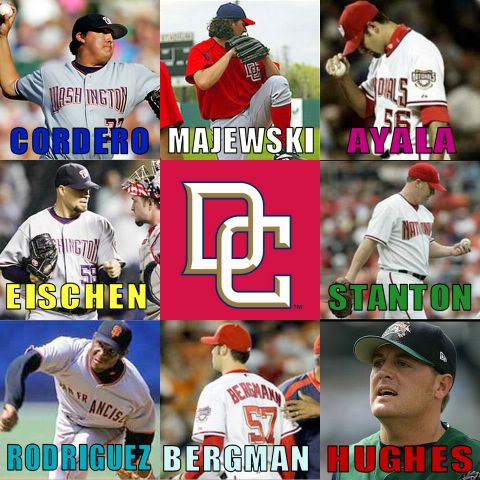 [February 17th] -- Why is it that bloggers and beat writers are paying so much attention to the Washington Nationals reserves these days, in particular the team's bullpen? Because we're trying to dig up good news to report so close to the beginning of spring training.
[February 17th] -- Why is it that bloggers and beat writers are paying so much attention to the Washington Nationals reserves these days, in particular the team's bullpen? Because we're trying to dig up good news to report so close to the beginning of spring training.
And, let me tell you, the bullpen is good news.
There is going to be some real competition this spring for the available spots in the team's pen. Chad Cordero, Gary Majewski, Luis Ayala, Joey Eischen and Mike Stanton are guaranteed spots on the opening day roster. If the Nats carry twelve pitchers and six starters (assuming the loser of the Ryan Drese/Tony Armas Jr. battle goes to the bullpen), there remains one position open and three men to fill it. The battle will likely be between newcomer Felix Rodriguez and Jason Bergman, who pitched very well last season. Travis Hughes, and probably Bergman, will be the odd men out to start the season.
How good is the Nationals bullpen? Very good. In a combined 347 innings last season, the team's returning pitchers gave up 335 hits and walked 120 while strikeout out 239, a 2:1 strikeout to walk ratio. They combined for a tremendous 2.51 ERA. They allowed an average of 1.3 baser unners per inning. The Braves' bullpen was horrible by comparison. The division champions threw 363 innings and gave up 387 hits. They struck out 281 while walking 169. They had an ERA of 4.66 and allowed 1.6 base runners per inning. Their strikeout to walk ratio was only 1.6:1.
Great teams don't need great bullpens, but average teams most certainly do. Some in the Nats' blog-o-sphere grow weary of having only the bench and bullpen to be proud of. However, for a team like the Nationals, the reserve players can make the difference between a 70 win season and an 85 win season.
With spring training about to start, I think a number somewhere in the middle seems to make sense.
The Meaning of Spring Training ...
 [February 17th] -- Over the next week or two, stories about spring training will become a "target rich environment." Professional scribes like Jayson Stark, as well as amateur word-crafters like jammingecono will begin to pen stories about the meaning of spring training. With eloquence, terms like "spring cathedrals" and "memories of my youth" will begin to dot the landscape of baseball blogs and magazines of every make and manner. Craftily worded metaphors will connect baseball to all things right and righteous. Concepts like patriotism and a strong work ethic will flap in the breeze of their pleasant prose. Word-pictures will tell the stories of both the grizzled veteran sweating off his winter fat as well as the chiseled youngster with an ego as vast and as deep as his untapped potential. We will read these stories and they will make us smile, because they will reflect memories of our childhood, a kind of "Field of Dreams" flashback but with real players and real fields and embedded dreams from our youth. And like in the movie, the promise of "If you build it, he will come" still rings true.
[February 17th] -- Over the next week or two, stories about spring training will become a "target rich environment." Professional scribes like Jayson Stark, as well as amateur word-crafters like jammingecono will begin to pen stories about the meaning of spring training. With eloquence, terms like "spring cathedrals" and "memories of my youth" will begin to dot the landscape of baseball blogs and magazines of every make and manner. Craftily worded metaphors will connect baseball to all things right and righteous. Concepts like patriotism and a strong work ethic will flap in the breeze of their pleasant prose. Word-pictures will tell the stories of both the grizzled veteran sweating off his winter fat as well as the chiseled youngster with an ego as vast and as deep as his untapped potential. We will read these stories and they will make us smile, because they will reflect memories of our childhood, a kind of "Field of Dreams" flashback but with real players and real fields and embedded dreams from our youth. And like in the movie, the promise of "If you build it, he will come" still rings true.
For they built it. And I came.
I left D.C. a half-decade after the Senators did. Washington just didn't seem the same after RFK went dark during the city's hot, humid nights. I lived a few years in Denver, watching The Denver Bears play at Mile High Stadium. One night, their second baseman, 35 and old for 'AAA' ball, was given an award at home plate. He had just graduated from law school. When the master of ceremonies asked the player what he was going to do next, he replied that he'd like to manage in the big leagues one day. His name was Tony LaRussa. I joined the Air Force in the late 1970's and spent my first tour-of-duty in Japan, and learned that baseball was indeed a universal language. I saw Sadaharu Oh drive a ball deep over the right field fence at Korakuen Stadium in Tokyo. Following my discharge in the early 1980's, I saw Carl Yaztremksi play at Fenway Park, Carlton Fisk squat behind the plate at Comisky Park, and watched a woeful Mariners' team draw but a handful of fans to the cavernous Kingdome. Kirk Gibson impressed me as he roamed the outfield at Tiger Stadium, covering the same turf that Al Kaline once did. And, of course, there were the games in Baltimore, but I try to forget them as best I can.
As much as I loved watching summer baseball, I desired to experience it's prequel, it's birth, it's beginning. I wanted to experience spring training. Not just a game, or a series, mind you. I didn't want to be baseball's guest; I wanted to be it's neighbor and friend. By 1985, however, it seemed that it would never happen.
I was living in St. Louis, emersed in both mortgage and marriage. My children kept me busy and my job kept me chained to a nine to five routine that never seemed to change. Most every night, Jack Buck and Mike Shannon would send 50,000 wats through my radio receiver, electrifying both me and the city that year.
 My only outlet, as it had been my entire life, was baseball. I was in St. Louis that magical year of 1985 when the two Missouri teams met in the World Series. Bush Stadium rocked with "Whitey Ball," Whitey Herzog's "run and gun" Cardinals that featured solid pitching and seven players capable of stealing 30 bases. The Cardinals, however, weren't really a baseball team. They were a compilation of speedsters who learned how to make a baseball do strange things on plastic grass. Bad, plastic grass. I was saddened by my first view of the field at Busch Stadium. I entered through a portal on the first base side to find that the field wasn't green at all. A decade of abuse by both Cardinal teams and the hot Missouri sun left the first generation Astro-turf a color more resembling white than green. This wasn't baseball. Men in tight double-knit uniforms springing accross an asphalt blacktop covered with a 3/8" pad and a 1/4" turf couldn't be the same sport that once featured heroes in baggy flannels playing on dew covered grass. But it was.
My only outlet, as it had been my entire life, was baseball. I was in St. Louis that magical year of 1985 when the two Missouri teams met in the World Series. Bush Stadium rocked with "Whitey Ball," Whitey Herzog's "run and gun" Cardinals that featured solid pitching and seven players capable of stealing 30 bases. The Cardinals, however, weren't really a baseball team. They were a compilation of speedsters who learned how to make a baseball do strange things on plastic grass. Bad, plastic grass. I was saddened by my first view of the field at Busch Stadium. I entered through a portal on the first base side to find that the field wasn't green at all. A decade of abuse by both Cardinal teams and the hot Missouri sun left the first generation Astro-turf a color more resembling white than green. This wasn't baseball. Men in tight double-knit uniforms springing accross an asphalt blacktop covered with a 3/8" pad and a 1/4" turf couldn't be the same sport that once featured heroes in baggy flannels playing on dew covered grass. But it was.
My daughter Kendi was three at the time. She was severely and profoundly handicapped, and in need of constant care and medical attention. Her mother and I almost lost her just before Christmas. Her fragile little body couldn't handle another St. Louis winter. The doctor broke the bad news in her hospital room. "I'm sure you love living here in St. Louis, Mr. Rushdi, but for the sake of your daughter's health, you need to move to Florida."
Two weeks later, we were on the road. The pavement remained snow covered and the sky remained gray and silent until the Georgia border. By Atlanta, the sky was blue. By Jacksonville, the temperature began to rise. When we pulled into our new driveway in West Palm Beach, it was January. January and 74 degrees. As my wife began to make sense of the boxes and baggage that littered our new home, I made a quick run to the Home Depot by way of the West Palm Beach Municipal Stadium. The gates were open and inviting.
 The grounds crew was milling around the infield, working in new dirt around the third base bag. I took a walking-tour of the complex. There were three batting cages and two regulation size fields. In the back of the complex was two diamonds with no accompanying outfields. "For infield practice" a worker told me. The Atlanta Braves and Montreal Expos shared the facility, and employees from both teams scurried about, painting and hammering, grooming and renovating. It was less than a month before players reported. I returned home and helped my wife unpack. Spring training hadn't even started yet, and I was hooked.
The grounds crew was milling around the infield, working in new dirt around the third base bag. I took a walking-tour of the complex. There were three batting cages and two regulation size fields. In the back of the complex was two diamonds with no accompanying outfields. "For infield practice" a worker told me. The Atlanta Braves and Montreal Expos shared the facility, and employees from both teams scurried about, painting and hammering, grooming and renovating. It was less than a month before players reported. I returned home and helped my wife unpack. Spring training hadn't even started yet, and I was hooked.
I made sure that I didn't start my new job until well after spring training began. I arrived at the complex close to 8:oo every morning and stayed until the players left, usually around 3:00 or so. A very elderly man from New York told me that I'd see more players on the golf course than on the ball field. He laughed as he said it. In his mouth was a pipe with a cigar pushed into it's bowl. I asked him about it. He smiled and winked. In a gravelly voice worn rough by a life fully lived, he said in the most stereotypical of New York accents, "My doctor, he said that never again a cigar should touch my lips. On that day, he said, I should die." He bent his head a little to the left and finished, saying, "Kid, it 'aint touching my lips." That was his last spring training.
One day, I had just gotten out of my car, and was heading towards the right-field fence when I saw Bobby Cox, then the Braves general manager, pull up next to me. "Hiya Bobby!" I shouted. He paused and looked at me, then broke into a toothy smile and waved as he walked towards the players entrance. He was five years away from winning his first championship with the Braves. Another day found Dale Murphy surrounded by a throng of star-struck kids. He signed and signed until they all left with their small pieces of baseball history. He looked up at me and smiled, looking for something to sign. He cocked his head and took a second look and said, "Don't I know you?" Dale Murphy and I attended the same church. He had seen me there. Once. And he remembered. He asked me how my daughter was doing. He remembered she was in a wheel chair. He asked if he could help give her a blessing. Later that day, He hit a 470 foot home run off of Tippy Martinez of the Orioles. I saw him at church that Sunday.
 "Aw, he just got it up a bit" was all Murph would say.
"Aw, he just got it up a bit" was all Murph would say.
I visited Ft. Lauderdale and watched the Royals take on the Yankees. I saw George in the owner's box. Charley Leibrandt was warming up for Kansas City in the 6th inning. At that time, the bullpen was along the left field fence next to the stands. The pitcher's rubber was four feet from the fence. As I leaned against the chain-link, I could have reached out and touched him on the shoulder. He pretended I wasn't there. I pretended I was him. I saw the Reds in Plant City, and the Twins in Orlando. I took in many Expos games in West Palm as well. Watching the games was fun, but watching the practices was even better. I saw a tall 25 year old pitch six solid innings against the Orioles. He struck out six and walked one, giving up only a run scoring double. His name was Randy St. Claire, the current pitching coach of the Nationals.
 In the third inning of a game in Orlando, I left my wife for a few moments to use the rest room. On my way back, I stopped and asked the blue-haired lady in the concession stand if they sold "authentic" Twins caps. She said no. As I turned to walk away, an athletic young man asked me if I wanted the "real thing." "Sure," I said. He walked me towards the clubhouse door, which was a simple metal door along the side of the stands at Tinker Field. He opened it and motioned me inside. It was the middle of the game and no one was there. He pulled a uniform out of a locker and grabbed a hat that was emblazoned with the "O" "T" logo for the Orlando Twins. The jersey belonged to a Minnesota Twins player. "I'll give you both for $25" said the young man. "Won't they be missed?" I asked. "Ah, I'll tell 'em someone stole them." I returned to my seat with a brown paper bag that contained my prizes. The jersey number was 21. To this day, I have been afraid to look up whose jersey I stole / purchased. Somethings are better left unsaid.
In the third inning of a game in Orlando, I left my wife for a few moments to use the rest room. On my way back, I stopped and asked the blue-haired lady in the concession stand if they sold "authentic" Twins caps. She said no. As I turned to walk away, an athletic young man asked me if I wanted the "real thing." "Sure," I said. He walked me towards the clubhouse door, which was a simple metal door along the side of the stands at Tinker Field. He opened it and motioned me inside. It was the middle of the game and no one was there. He pulled a uniform out of a locker and grabbed a hat that was emblazoned with the "O" "T" logo for the Orlando Twins. The jersey belonged to a Minnesota Twins player. "I'll give you both for $25" said the young man. "Won't they be missed?" I asked. "Ah, I'll tell 'em someone stole them." I returned to my seat with a brown paper bag that contained my prizes. The jersey number was 21. To this day, I have been afraid to look up whose jersey I stole / purchased. Somethings are better left unsaid.
When my daughter's health permitted, my family left Florida and relocated to the mountains of SouthEast Idaho. I can't say that I necessarily miss spring training, because I saw all there was to see, did all there was to do, and learned all there was to learn about the shadow-side of baseball's annual rebirth. It was a joyous time, though. Spring training touched my heart as I thought it would, and allowed me to understand baseball from a uniquely different perspective. I was able to observe first hand not the joy on the face of the fans, but on the players themselves. They were the kids, they were the ones living vicariously through their heroes as they did when they were little. The smiles never left their faces.
Spring training was everything I hoped it would be. Fans and players were friends. 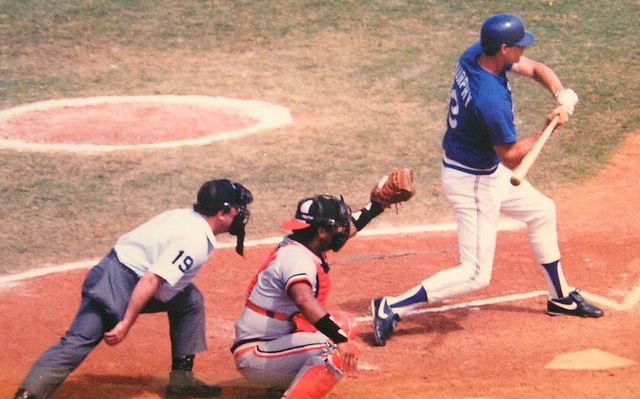 More than once I saw a player having a catch with a young fan in the stands. Memories that would last a lifetime were created a hundred times a day in a dozen cities throughout the state. I don't want to go back, though. My spring training doesn't exist any more. Today's spring training is carefully choreographed and sold to the highest bidder. Tickets are priced not for the average fan but for the "exclusive" groupy-fans that follow them each February. My spring training was innocent and open to the public for free. The stands were full with fans both too young, and too old to drive. No longer is the game available to the average pensioner. My game day was about $4.00; $6.00 if you include the dog and the Coke.
More than once I saw a player having a catch with a young fan in the stands. Memories that would last a lifetime were created a hundred times a day in a dozen cities throughout the state. I don't want to go back, though. My spring training doesn't exist any more. Today's spring training is carefully choreographed and sold to the highest bidder. Tickets are priced not for the average fan but for the "exclusive" groupy-fans that follow them each February. My spring training was innocent and open to the public for free. The stands were full with fans both too young, and too old to drive. No longer is the game available to the average pensioner. My game day was about $4.00; $6.00 if you include the dog and the Coke.
It was the cheapest memories I ever purchased. And they were the best.
Musical Chairs About To Begin In Viera
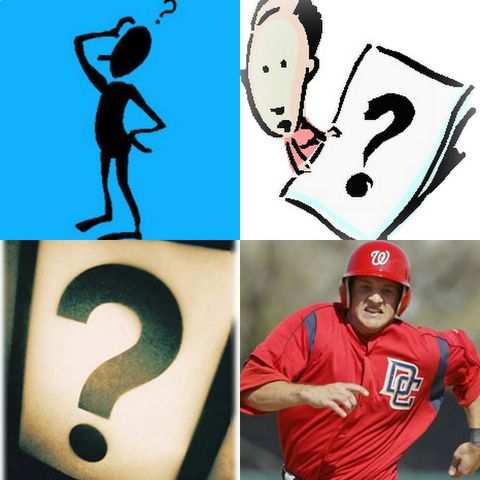 [February 16th] - Well, it's over. Thankfully, mercifully, the past five weeks of uncertainty ended yesterday with Sammy Sosa's realization that his gas tank was indeed empty. But I still feel a bit numb, somewhat c0nfused and altogether unsure of the direction my beloved Nationals are heading.
[February 16th] - Well, it's over. Thankfully, mercifully, the past five weeks of uncertainty ended yesterday with Sammy Sosa's realization that his gas tank was indeed empty. But I still feel a bit numb, somewhat c0nfused and altogether unsure of the direction my beloved Nationals are heading.
And spring training has arrived.
The Sosa conundrum was but one of several scenarios that were waiting to play out. At virtually every position, there is some intrigue, some question mark just waiting to be asked.
The big question here is will Nick Johnson stay healthy? If the past six years is any indicator, the answer is no. And what if he does stay healthy? He is a free agent after the 2006 season and there is no way any right-minded general manager will offer him a long-term deal with his baggage. The Nationals have a bucket-load of serviceable first baseman and a likely replacement in the form of Larry Broadway, just a few hundred at-bats and a plane ticket away.
Where do I begin? Jose Vidro, who has joined Nick Johnson on the disabled list the past three seasons, says he's healthy and ready to play 160 games. Well, maybe. Then there's Alfonso Soriano, who says he'll play for the Nationals in 2006, but he's going to do it at second base. Vidro can only play second base. Behind the two former all-stars are Damian Jackson and Marlon Anderson, both capable replacements. Kinda gives "depth" a new meaning, doesn't it?
The Nationals have a returning starter with three years and $12 million dollars remaining on his contract that may lose his job to a guy with funny-hair and a minor league contract. The big money guy batted .219 last year and the funny-hair guy batted .270. The team's general manager is going to give the funny-hair guy every opportunity to beat the big money guy. Go figure.
If history is any barometer, Ryan Zimmerman has just as much of a chance to win the rookie-of-the-year award as he does batting .188 through May and finding himself a Zephyr. If he doesn't make it, Jim Bowden has said that Brendan Harris would be given an opportunity, as would Damian Jackson.
bb
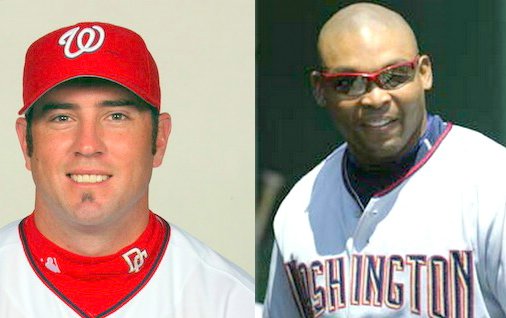 LEFT & CENTER FIELD: Alfonso Soriano. Ryan Church. Marlon Byrd. Brandon Watson. Michael Tucker. And two starting positions. If Brandon Watson wins the centerfield job, and Alfonso Soriano relents and plays in the outfield, Ryan Church is out of luck. If Church starts, Watson's out. If Soriano gets traded, but Watson plays poorly in spring ... well, you get the idea.
LEFT & CENTER FIELD: Alfonso Soriano. Ryan Church. Marlon Byrd. Brandon Watson. Michael Tucker. And two starting positions. If Brandon Watson wins the centerfield job, and Alfonso Soriano relents and plays in the outfield, Ryan Church is out of luck. If Church starts, Watson's out. If Soriano gets traded, but Watson plays poorly in spring ... well, you get the idea.
RIGHT FIELD & CATCHER: Jose Guillen is entrenched in right field, but exactly when will that "entrenching" begin? Will Guillen's shoulder allow him to play in April? May? Brian Schneider is healthy, happy, and one of the best catchers in the National League.
So, even without Sammy Sosa, the Nationals have a grand total of ONE position that is set and locked in for opening day. Brian Schneider is a given. But the rest of the team is facing more intrigue than a 40's spy movie. If Alfonso Soriano is traded, who will that bring in return and where will he play, and who might the team have to trade to make room for that player? Makes the brain cramp just thinking about it.
Last season, Endy Chavez was the only question mark facing the team as spring training began. My, how simple life was in the old days.
So-So A No Show, All Is Good To Go-Go
 [February 15th] -- Well, the great Sammy Sosa adventure is over. Adam Katz, Sosa's agent, has told Nationals general manager Jim Bowden that he will not accept the team's non-guaranteed offer to join the club for 2005.
[February 15th] -- Well, the great Sammy Sosa adventure is over. Adam Katz, Sosa's agent, has told Nationals general manager Jim Bowden that he will not accept the team's non-guaranteed offer to join the club for 2005.
Just too beneath him, I guess. I'm beginning to wonder if he was stringing the Nationals along in hopes of finding a "better fit" [read: more money] elsewhere. Why else would the mercurial [read: cheating] outfielder have waited for almost two months before making his decision, just days before spring training.
Props to big Frank Thomas, who took a similar contract to renew his career with the Oakland Athletics. He wasn't bigger than the game, it seems. Sosa feels that he's above and beyond having to prove himself [read: run during spring training] after all he's done for major league baseball. Hurrumph.
I was initially for a Sosa signing, but at the expense of Alfonso Soriano and not Ryan Church and Marlon Byrd. It was never my hope to see Sosa in the same outfield with Soriano and Jose Guillen. Now, the team will again look "in house" for their third outfielder; a position that Church or Byrd [but not Watson] should ably fill.
Thanks, Sammy. You saved the Nationals the embarrassment of seeing another quality player traded to the hinterlands so that you could bat .220 in Washington.
Judging Jimmy
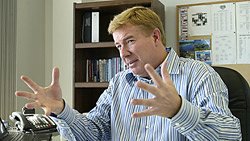 [February 15th] --From October 16th 1992, when he became the youngest general manager in baseball, to July 26th 2003, when he was fired by the Reds, Jim Bowden made 101 trades in 10 seasons, an average of 10 a year. While the baseball world knows him as "Trader Jim," no one has ever broken down those 101 trades to see if the "boy GM" helped or hurt The Reds.
[February 15th] --From October 16th 1992, when he became the youngest general manager in baseball, to July 26th 2003, when he was fired by the Reds, Jim Bowden made 101 trades in 10 seasons, an average of 10 a year. While the baseball world knows him as "Trader Jim," no one has ever broken down those 101 trades to see if the "boy GM" helped or hurt The Reds.
Let's do that now. Many of the trades sent minor leaguers to another club in return for minor leagers, none of which made an impact with either club. The vast majority of his trades were of this type. We'll look at the "name" trades that Bowden made.
1] 11-3-92 -- Paul O'Neill and Joe DeBerry sent to the Reds for Roberto Kelly. Roberto Kelly had just come off a .272-10-66 season for the Yankees, and Paul O'Neill had hit 95 homers over four seasons with the Reds. O'Neill went on to be an integral part of the Yankees' championship run, and Roberto Kelly bounced around the major leagues until retiring in 2000.
2] 11-17-92 -- Norm Charlton sent to the Mariners for Kevin Mitchell. Charlton had saved 26 games with the Reds in 1992, and Mitchell had an off-year with the Mariners after coming to Seattle from the Giants the previous season. Charlton was a very "iffy" reliever for the Mariners during the mid 1990's while Mitchell batted .341 and .326 with a combined 49 homers in his two years with Cincinnati.
3] 11-2-93 -- Bobby Ayala & Dan Wilson sent to the Mariners for Bret Boone and Erik Hanson. Wilson became the starting catcher for the Mariners for more than a decade and Ayala was one of the few credible relief pitchers that the Mariners had in the 1990's. Hanson played one uninspired year with the Reds and Boone showed traces of brilliance but was traded to the Braves before fully blossoming.
4] 5-11-95 -- C.J. Nitkowski, David Tutle & Mark Lewis traded to the Tigers for David Wells. Nitkowski is still bouncing around the league ... Mark Lewis had a few "low-level" productive years in the major leagues. David Wells won six games for the Reds before being traded again
5] 12-26-95 --David Wells traded to the Orioles for Curtis Goodwin and Trovin Valdez. Wells went on to become one of baseball's best pitchers and Goodwin became a seldom used backup outfielder. Valdez never made it to the major leagues.
6] 5-27-97 -- Chuck McElroy traded to the Angels for Lee Smith. McElroy never did much in the major leagues, either before or after the trade. Smith was at the end of his career, and didn't help the Reds at all. He retired two years later.
7] 3-30-98 -- Dave Burba traded to the Indians for Sean Casey. Casey has been the starting first baseman for the Reds since the trade (and was traded to Pittsburgh this off season), and Burba won 56 games over the next four seasons with the Indians and the Rangers.
8] 7-4-98 -- Jeff Shaw traded to the Dodgers for Paul Konerko and Dennys Reyes. Shaw was an average middle reliever for the Dodgers until his retirement in 2001 ... Reyes is still in the league today as a borderline reliever. Korerko was traded before making an impact in the league.
9] 11-10-98 -- Bret Boone and Mike Remlinger traded to the Braves for Denny Neagle, Rob Bell and Michael Tucker. Neagle has not had a quality season since the trade .. Rob Bell has a career ERA near 6.00. Tucker did a good job for the reds as a platoon right fielder. Remlinger has been a "stud" reliever for several teams since the trade, and Bret Boone became one of the best 2nd baseman in the league.
10] 11-11-98 -- Paul Konerko traded to the White Sox for Mike Cameron. Cameron has had some decent years in the major leagues, but his bat has never quite caught up to his outstanding glove. Kornerko is today one of the best slugging first baseman in all of baseball.
11] 2-2-99 -- Reggie Sanders, Damian Jackson and Josh Harris traded to the Padres for Greg Vaughn and Mark Sweeney. Vaughn hit 45 homers for the Reds before signing with the Devil Rays ... Mark Sweeney has been a utility player during his career. Reggie Sanders has battled injuries during his career but is still producing in the major leagues. Jackson just signed with the Nationals & Josh Harris never made it to the major leagues
12] 2-10-2000 -- Brett Tomko, Mike Cameron, Antonia Perez and Jake Meyer to the Mariners for Ken Griffey Jr. The "mother" of all trades -- Griffey has never been healthy during his five years with the Reds. Tomko continues to pitch in the major leagues, but barely. Cameron did well with the Mariners before signing a free-agent contract with the Mets. Perez and Meyer have yet to make an impact in the "bigs."
13] 3-21-2001 -- Drew Henson and Michael Coleman traded to the Yankees for Wily Mo Pena. Henson is now with the Dallas Cowboys, and Coleman had a "cup of coffee" or two with the Red Sox. Pena has had several productive years with the Reds
So, out of 101 trades, there was only thirteen that had any real impact on either the Reds or the team Bowden traded with. The great majority of his trades were of the "Cary Ammons for Donnie Sadler" variety. Looking back over his 10+ seasons as the Reds' general manager, it becomes apparent that he really didn't have much of an impact. None of the transactions won the team a pennant they otherwise wouldn't have won, and none of the transactions buried the Reds for a few seasons until they could recover.
I guess it goes back to the old saying, that "it's the quality and not the quantity that counts."
As Lease Signing Nears, Some Thoughts On How To Play Baseball In D.C.
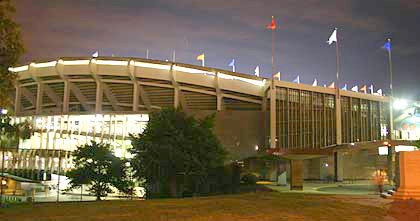 [February 14th] --Oakland reliever Justin Duchscherer felt it. All of the Oakland Athletics players and coaches noticed it. They had thought playing at RFK Stadium would be similar to Camden Yards in terms of the weather, but it wasn't. Said Duchscherer, "Our starting pitchers were coming into the dugout after the third or fourth inning and saying, 'Man, I'm done, I'm out of gas.'" This was in June of last year.
[February 14th] --Oakland reliever Justin Duchscherer felt it. All of the Oakland Athletics players and coaches noticed it. They had thought playing at RFK Stadium would be similar to Camden Yards in terms of the weather, but it wasn't. Said Duchscherer, "Our starting pitchers were coming into the dugout after the third or fourth inning and saying, 'Man, I'm done, I'm out of gas.'" This was in June of last year.
While some players see the humid weather as a friend to the Nationals, kind of a sticky version Denver's "mile high" advantage, other players see the stadium as the real home field advantage. Players refer to it as "Retro Field" and "The Great Outback." Billy Wagner joked, "Isn't this how stadiums looked during the dead-ball era?" Florida catcher Paul LoDuca said it best:"RFK is huge. A lot of guys come back to the dugout shaking their heads." The entire National League East is based on big, burly home run hitters, that "station to station" kind of scoring that would make Earl Weaver proud. That doesn't work at RFK. The teams who can downshift, pop the clutch and switch gears can win there. But please, don't ask Ryan Howard to steal 2nd with two out.
The great majority of players today have never played in a "real" baseball park, one where you had to earn your home runs by crushing the ball with all your might. They don't know a time when opposite field homers were rare. In 1991, Camden Yards became the "cookie cutter" design that the next generation of stadiums were patterned after. Foul ground was replaced by expensive box seats. The total square footage of fair territory in these new stadiums was down by as much a 4%. Check swings became doubles to the wall. Pop flies became home runs. Bad players became sluggers and sluggers became hall-of-famers. When the Expos moved to Washington, old school baseball was back in business.
Opposition hitters have complained since opening day that the fences were much farther than their markings indicate. "Too much foul ground" they complained. Home run hitters didn't feel quite as strong when they stepped to the plate at RFK. Some of these complaints are true, of course, but mostly, RFK has "freaked out" the opposition. Mike Lowell said, "I'm standing near third base, and I look over to the stands and, man, it's like their bouncing up and down. I'm not an engineer or anything, but I'm pretty sure that's not supposed to happen. I kept waiting for the whole thing to come tumbling down on me." Luis Gonzales was not as concerned with the stadium itself, but who was there. "The Box seats are like a who's who in politics." Players are watching their President instead of the hitter.
Memo to the HOK architects, the folks designing the new stadium: The Mayor has assured Washingtonians that our new stadium will not be a carbon copy of Camden Yards, or Jacobs Field, or any of the other band-boxes that dot the MLB scene today. Good. But you have to go farther. Leave the field a wide expanse. Keep the foul territory both generous and ample. Force the Nationals to create a team that is fast and defensively sharp. Keep a bevy of quality pitchers on the staff. Bring in a bunch of line drive hitters to fill the roster. Sean Casey is an example of the type of player that would do well at the new, large park. Sean Casey can hit a line drive into the gap at Camden Yard for a double. Sean Casey can hit that same line drive into the gap at RFK or it's replacement and find himself at third base. This quick, line drive type of offense will work here in Washington, and will work well in Philadelphia or Cincinnati. The reverse doesn't hold true, however. Many of Carlos Delgado's long drives will be caught on the warning track at RFK, and it's hard to change the makeup of a team for a 3 game series.
Washington's fans are watching real baseball at RFK. We're beginning to again realize that triples are just as exciting to watch as a home run, that speed has a value equal to power. I hope that the new stadium will be created to keep making the opposing teams upset about it's dimensions and design. Luis Gonzalez complained about the small size of RFK's visitors clubhouse. Fine. Make is smaller. Mike Lowell didn't like the way the 3rd base stands bounced. Cool. Make ALL the stands bounce. It's these distractions that give teams like the Nationals the edge. No reason at all these "edges" have to stay behind when the team moves to the new park.
Rethinking The Matt LeCroy Signing
 [February 13th] -- When I first caught wind of the Matt LeCroy signing, I was very happy. He was a good-ol boy from South Carolina with an aw-shucks drawl and a big-boy build. He was just like Jamey Carroll except for, well except for everything other than the fact that they're both nice guys. He can't hit right-handers, sure, thats right, but he crushes lefties; just destroys them. In just 124 at-bats, LeCroy launched 13 home runs and sported a .306 batting average with a .404 on base percentage. Pair him up with Daryle Ward at first, trade Nick Johnson for pitching and call it good.
[February 13th] -- When I first caught wind of the Matt LeCroy signing, I was very happy. He was a good-ol boy from South Carolina with an aw-shucks drawl and a big-boy build. He was just like Jamey Carroll except for, well except for everything other than the fact that they're both nice guys. He can't hit right-handers, sure, thats right, but he crushes lefties; just destroys them. In just 124 at-bats, LeCroy launched 13 home runs and sported a .306 batting average with a .404 on base percentage. Pair him up with Daryle Ward at first, trade Nick Johnson for pitching and call it good.
Never trust American League statistics.
I revisited LeCroys numbers and looked a little deeper into the splits. Uh oh. He excelled in the Metrodome, batting .305-10-28, .925 ops. Away from his little bandbox, however, he only hit .213-7-21, .668 ops. On artificial turf, he hit .293-11-31, .897 ops, while he struggled on grass to the tune of .219-6-29, 679 ops.
So, playing in a small park that features astro-turf, he's Roger Maris. In a grass covered traditional field, he's Roger Metzger.
I'm not suggesting that LeCroy wasn't a good signing. I am saying that we have to discount American League stats when looking at the worth of a player. Alfonso Soriano falls into this same category; great at home and bad on the road. Batters want to play in the American League and pitchers want to play in the National League. That's just the way it is.
Matt LeCroy is still a good ol boy who will help the Nationals. He just might not help them quite as much as I'd hoped.
What To Make of Sosa Demand
 [February 13th] -- At first blush, Sammy Sosa's demand for a guaranteed $1 million dollar contract seems contrived.
[February 13th] -- At first blush, Sammy Sosa's demand for a guaranteed $1 million dollar contract seems contrived.
And it is.
The Nationals have offered a non-guaranteed, $500,000 contract, to which Bowden has flatly stated several times "We're done." So why the "$1 million or bust" demand from Sosa agent Adam Katz Sunday night? Well, let's look at a few possible scenarios
- In a world without steroids and cork, Sammy Sosa realizes that his tank is "empty" and he doesn't have the skills or stamina (or perhaps even the desire) to return to major league baseball for an 18th season and will use the "disrespectful nature" of the Nationals' offer as cover to end his career with dignity.
- Sammy Sosa really wants to play another year to avenge both his honor and his horrible year in Baltimore. He and Adam Katz have thrown out the "million dollar demand" as a negotiating tool, and probably are only seeking to have the contract guaranteed (even at $500,000).
- Sammy Sosa believes that he is able to answer the bell and play in 2006, but truly believes that accepting a $500,000 non-guaranteed deal is beneath him and is willing to end his career on a sour note rather than play for the pittance the Nationals are offering.
Of those three, the "negotiation" scenario seems the most likely. Sosa wants to sign and his ego demands that he prove he is still a top-caliber major league player, but he doesn't want to be chided by his friends and fans for accepting a "non guaranteed" deal. And to some extent, I agree with him. Sammy Sosa has earned the respect of major league baseball to come to spring training with a guaranteed contract. A $500,000 guaranteed contract, not the $1 million he demands. If his abilities remain, the multiple incentives embedded within the contract will make the squabble over guaranteed money insignificant. I think he's holding out for a modicum of respect, a bread crumb so to speak. Fine. Give him the bread crumb. But only 500,000 of them.
The truth can now be revealed. Jamey Carroll was sold to the Colorado Rockies in anticipation of providing Sosa with a guaranteed contract in the $500,000 to $600,000 range.
Well, maybe not.
It's been my experience that public pronouncements during negotiations are little more than bluster designed to reach the fans. Any real demands would have remained private and never been revealed until after the negotiations were either successful or had failed.
Will Sosa be a National? I haven't a clue. Stay tuned.
Blogging On Hold As Math Test Reminds Me Why I'm 49 And Still A Senior In College
 [February 13th] -- I've got a killer math early this afternoon, so I won't be blogging until I either get through it or die of cardiac arrest while taking it.
[February 13th] -- I've got a killer math early this afternoon, so I won't be blogging until I either get through it or die of cardiac arrest while taking it.
I hate math. I hate it. I hate it. I hate it. For 25 years, my wife begged me to go back to school, and for 25 years, I told her I couldn't get through college math.
I've got a 3.88 GPA and if I pass this math course, I'll graduate in two semesters. If I don't pass it, I'll run out of student loans and Pell grants before I run out of classes to take, and it's back to doing what I don't want to do for the rest of my life.
Hopefully, you'll accept this as a good excuse for me to be away for a few hours, at least until I get through this test.
With my luck, in the five hours I cram this morning, and the one hour it takes to take the test, the stadium lease will be accepted by Bud Selig, a new owner will be named, Sammy Sosa will NOT sign a contract, Jim Bowden will be fired and Jared Weaver will sign with the Nationals.
Aaaaaaaaaaaaaaaaaaaaaaaaaaaaaaaaaaaahhhhhhhhhhhh. Focus, Farid Focus. A cake is valued at $12. Jose likes the chocolate part three times more than the vanilla. How much is each ..... slice ......
Man. I gotta pass this crap.
WAYBACK MACHINE: Plastic Grass At RFK??
 [February 12th] -- More than 30 years ago, Redskin owner Edward Bennett Williams announced the hire of a new, proven head football coach who would lead the team back to prominence in the NFL. This man had a few championships under his belt, and was known to be able to turn around an NFL team almost immediately. No. It wasn't George Allen. He came later. This was Green Bay legend Vince Lombardi. Lombardi turned the Redskins into winners in 1969, their first winning season in 14 years, and only their third since the Truman administration.
[February 12th] -- More than 30 years ago, Redskin owner Edward Bennett Williams announced the hire of a new, proven head football coach who would lead the team back to prominence in the NFL. This man had a few championships under his belt, and was known to be able to turn around an NFL team almost immediately. No. It wasn't George Allen. He came later. This was Green Bay legend Vince Lombardi. Lombardi turned the Redskins into winners in 1969, their first winning season in 14 years, and only their third since the Truman administration.
Lombardi found something new when the Redskins visited Franklin Field in Philadelphia, owned by the University of Pennsylvania and shared with the Eagles. Gone was the hard grass sod and in its place was a brand new artificial surface. Lombardi loved the feel of the Astroturf as he walked the sideline during the game. He told reporters that he intended to talk to the Armory board about changing over the RFK field to the artifical surface.The Armory board liked the idea of placing Astroturf in RFK Stadium. The cost, over ten years, would be far less expensive than the cost of maintaining a sod field. All that was left was to get approval from Senators owner Bob Short.
It never happened. Short, in perhaps the only wise move he made during his period of ownership in Washington, said "No way." The Armory board, and Lombardi indirectly, negotiated for sometime before finally giving up hope that an agreement could be reached. By the time that the Redskins became the sole occupant of RFK Stadium in 1972, Vince Lombardi had been dead for two years and George Allen was the new "sheriff" in town. This sheriff hated astro-turf. That ended any hope of plastic grass at RFK.
Bob Short did the right thing. Man, that is sooo hard to write.
Rockie Mountain High
 [February 11th] -- The first of many shoes dropped on Saturday. The Washington Nationals have sold utility outfielder Jamey Carroll to the Colorado Rockies for $300,000 cash.
[February 11th] -- The first of many shoes dropped on Saturday. The Washington Nationals have sold utility outfielder Jamey Carroll to the Colorado Rockies for $300,000 cash.
Selling a player like Carroll in this day and age is very unusual. The $300,000 price tag is but a fraction of the team's $60 million dollar payroll.
This move had to happen. With the addition of middle infielders Marlon Anderson and Damian Jackson, plus Brendan Harris' defensive improvement this past year, Carroll became expendable. My guess is this move was made specifically to create a roster spot for Brendan Harris, who will now be able to back up Ryan Zimmerman at third with little loss of offensive production. It has been his defense that has been keeping Harris in the minor leagues.
Jamey Carroll will be missed, I will miss him, not for what he brought to the field, but rather for the person he was. Carroll was like a lot of us, possessing limited physical stature and questionable talent. Still, he pushed himself using a work ethic that is almost unseen in today's instant gratification society. He cared more for his team then for himself. He spoke publicly about the Damian Jackson and Marlon Anderson signings, saying that he was happy that Jim Bowden improved the team.
Jamey Carroll is the kind of man I hope my son grows up to be.
Nats Turn Back On Ryan Church
 [February 11th] -- Ryan Church had a very good 2005 season; had he not been injured, it might have even been a great season. He batted .287-9-42 with a .353 on base percent and a .466 slugging average in 268 at bats. Had Church not been injured, he would have hit 20 home runs and driven close to 90 runs. A lefty, Church actually hits left-handers better than righties, and his defense is solid. He struck out too much in 2005, but he only had 63 at-bats in the major leagues before last season, so his strikeout total will likely go down as his experience increases. At 27, Church seemed ready to become a fixture in the Nationals' outfield for the next decade.
[February 11th] -- Ryan Church had a very good 2005 season; had he not been injured, it might have even been a great season. He batted .287-9-42 with a .353 on base percent and a .466 slugging average in 268 at bats. Had Church not been injured, he would have hit 20 home runs and driven close to 90 runs. A lefty, Church actually hits left-handers better than righties, and his defense is solid. He struck out too much in 2005, but he only had 63 at-bats in the major leagues before last season, so his strikeout total will likely go down as his experience increases. At 27, Church seemed ready to become a fixture in the Nationals' outfield for the next decade.
Wrong.
Nationals' general manager Jim Bowden continues to try to trade Church. During the MLB winter meetings, he thought he had an agreement that would have sent Ryan Church, Jamie Carroll and a minor leaguer to the Diamondbacks for pitcher Javier Vasquez, but Arizona pulled out of the deal at the last minute.
Jim Bowden doesn't question Ryan Church's talent; he questions his heart. According to Bowden, he couldn't answer the "bell" on opening day because of a slight groin pull and had to be replaced by Terrmel Sledge. A run-in with an outfield wall in Pittsburgh and a Ramon Martinez fastball in Cincinnati forced him to the disabled list twice in 2005. Bowden, and manager Frank Robinson to an extent, believed that Church wasn't hurt that badly and should have played through the pain. Church disagrees, saying that he knows his body better than anyone else.
Ryan Church knows that the team wants Brandon Watson to start in the outfield in place of him. He realizes that if Sammy Sosa signs a Nationals' contract, he'll be the teams 4th outfielder or on another team, probably the latter. Yet, Church isn't upset. "It is what it is," Church said. "They are signing guys to create competition. There's nothing wrong with that. You always want some healthy competition in Spring Training."
If given the opportunity, Church could give the Nationals a .300-20-85 season with a .365 on base percent. But he likely won't be given that opportunity, because his boss thinks he isn't tough enough.
C'mon Jimbo, stop being so subjective. Ryan is the 3rd best outfielder the team has. Let him play.
Rasner Now A Yankee
 [February 11th]-- The New York Yankees claimed the Nationals' Darrell Rasner off waivers on Friday. General Manager Jim Bowden had to clear a spot for the newly signed Matt LeCroy and chose to put Rasner, considered the 5th or 6th starter going into 2006, on waivers.
[February 11th]-- The New York Yankees claimed the Nationals' Darrell Rasner off waivers on Friday. General Manager Jim Bowden had to clear a spot for the newly signed Matt LeCroy and chose to put Rasner, considered the 5th or 6th starter going into 2006, on waivers.
It is impossible to tell at this point whether this is another mistake by general manager Jim Bowden or his simply removing an unwanted player from the 40 man roster. Last August, Bowden waived pitcher Sunny Kim, assuming that he would clear waivers and be assigned to 'AAA' New Orleans. The Rockies selected him, however, and he spent the final month and a half of the season in the Rockies starting rotation.
Rasner could have a bad arm. His velocity has dropped 5 mph in the past year; the Nats contend he's injured while Rasner says he's relying less on speed and more on finesse. It's difficult to say exactly "who's zooming who."
Rasner leaves the team with some animosity. He believed he should have been given more of a chance last September, but ended up spending a great deal of time in the bullpen. At 25, his future may still be bright.
Poor, Poor, Pitiful Thee
 [February 10th] -- Well, that didn't take long. As the two sides packed up their charts and paperwork yesterday, and threw away their empty Evian water bottles, head arbiter Richard Bloch smiled and said, "Thank you gentleman. We'll inform you of our decision by Saturday."
[February 10th] -- Well, that didn't take long. As the two sides packed up their charts and paperwork yesterday, and threw away their empty Evian water bottles, head arbiter Richard Bloch smiled and said, "Thank you gentleman. We'll inform you of our decision by Saturday."
He couldn't wait until then. He just had to wait until he could stop laughing.
For the second time in three tries, the team won and the player lost. I don't think it was ever in doubt. There is nothing in Alfonso Soriano's statistical history that would justify a salary of $12 million dollars. Sure, he hit 36 homers last season, but the great majority of them came in Texas' home park, which has dimensions only slightly larger than the little league field across the street. Sure, he leads all second baseman in homers over the past five years, but he also leads them in errors. Soriano has made 109 errors since 2002; Jeff Kent and Ray Durham are tied for second for the second most with 59.
What worries me the most is that Soriano believes he is worth the $12 million, and might let the "loss of face" effect his play this season. In his mind, he wasn't asking for more than he was worth; he was asking for what he was worth. History is replete with players who "phoned in" their effort after being beaten at the arbiters table.
I'm sure that the Nationals dissected Soriano like a frog in a biology tray. By the time it was all over, he probably wondered why he was even playing the game of baseball. Now, a day removed from the process, he is likely doubly angry; angry for the way the team treated him and angry that the way the team treated him led to his losing the $2 million, money that he believes he deserved.
In an interview with Florida Today, Bowden indicated that Jose Vidro was the team's second baseman, and that his talents and abilities didn't translate to his playing anywhere else. "If he's healthy, he plays second" said a very firm Bowden this morning.
So, let's recap. The Nationals have a second baseman who they want to play a position that he's never played. They have a player who is going to be a free agent at the end of the year, and in hopes of signing him to a long-term contract before then, spent an hour telling him to his face that he compared favorably to Mario Mendoza. Soriano believes he is worth $12 million and the Nationals are the reason he didn't get all of his money. And he vows never to play in the National League after this year.
Did I miss anything?


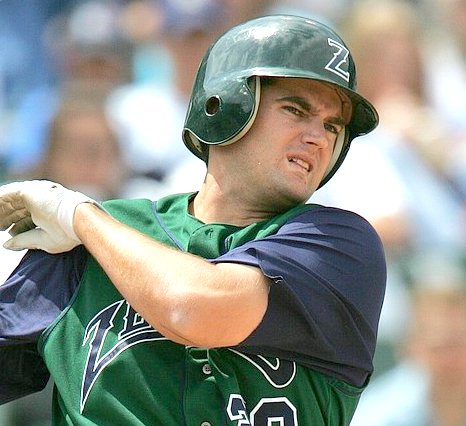









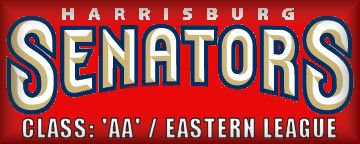
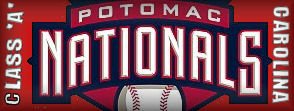

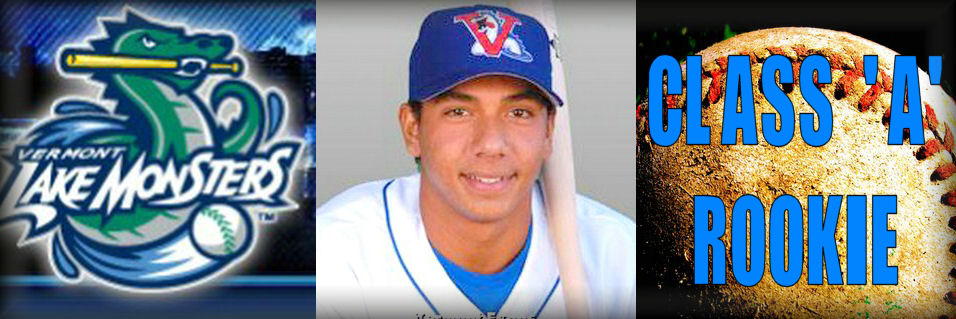











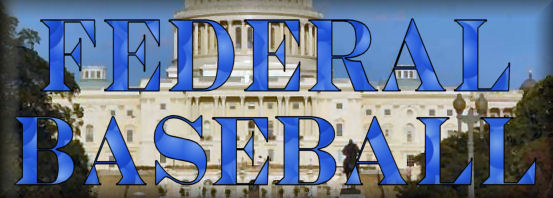



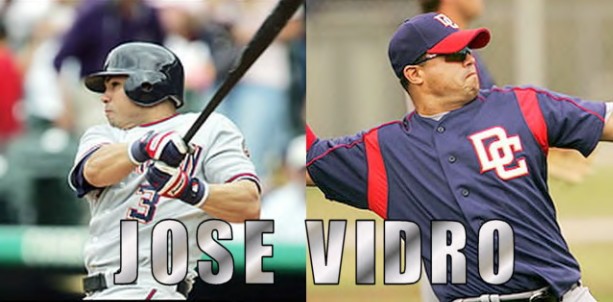




















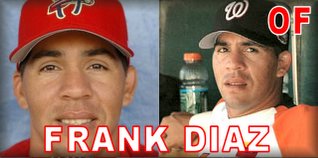

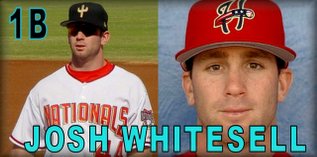
 3) 1926 (road) --- 4) 1936-'37, 1948-'51
3) 1926 (road) --- 4) 1936-'37, 1948-'51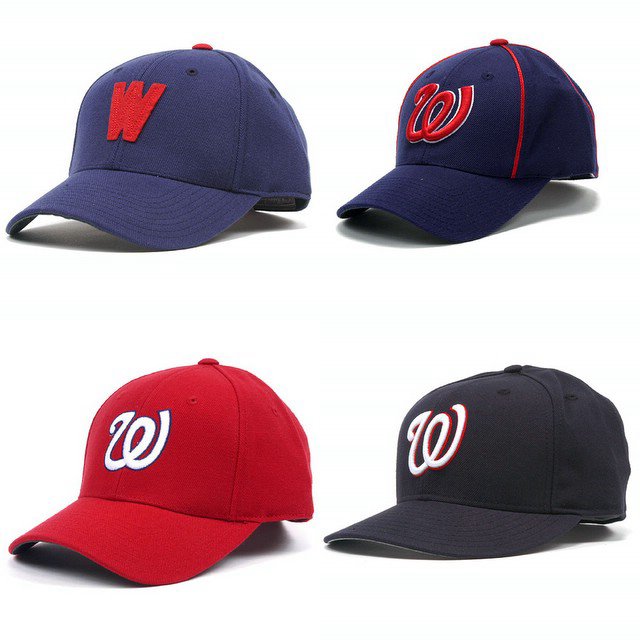 3) 1968 - '71, and 2005 (home) --- 4) 2005 (road)
3) 1968 - '71, and 2005 (home) --- 4) 2005 (road) Buddy Meyer --- Walter Johnson
Buddy Meyer --- Walter Johnson Ed Yost --- Muddy Ruel
Ed Yost --- Muddy Ruel Roger Peckinpaugh --- Joe Cronin
Roger Peckinpaugh --- Joe Cronin Del Unser --- Darold Knowles
Del Unser --- Darold Knowles Ed Stroud - Mike Epstein
Ed Stroud - Mike Epstein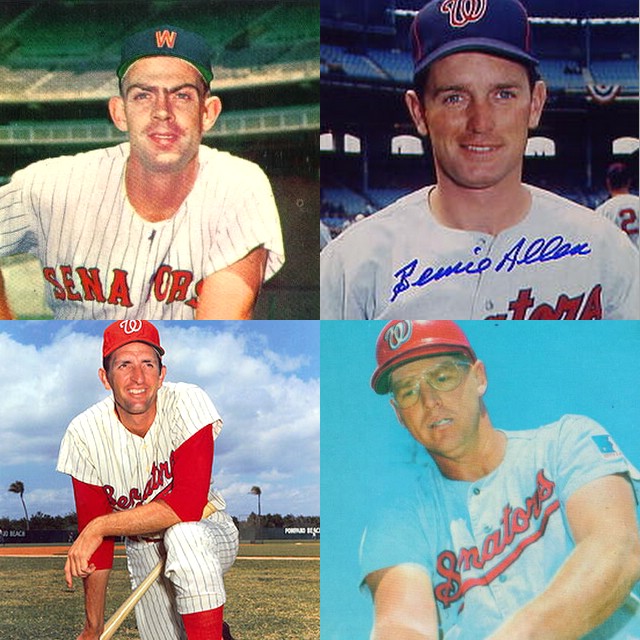 3)1968 -- 4)1969 - 1971
3)1968 -- 4)1969 - 1971